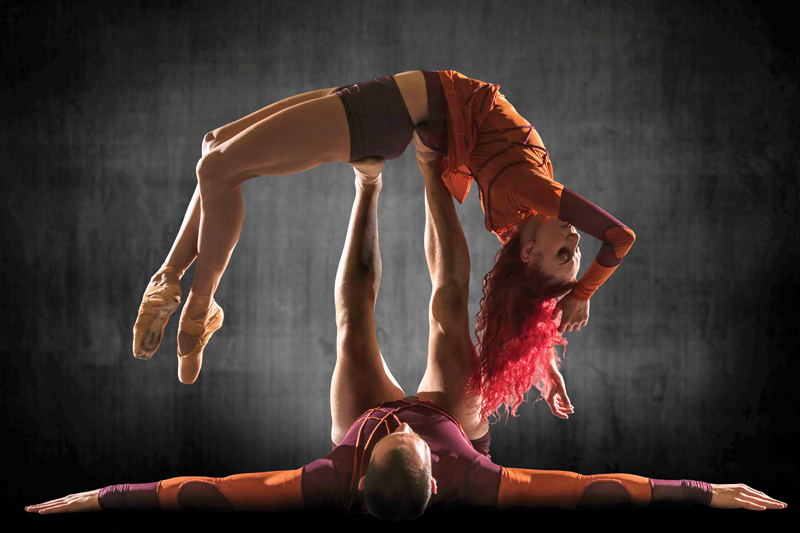BJM Danse: Pederneiras, Galili, Foniadakis, Millepied / Mixed Bill - Vancouver Ballet Society
- Home
- Reviews 2014 - 2019
- BJM Danse: Pederneiras, Galili, Foniadakis, Millepied / Mixed Bill

by Robin J. Miller
What a difference a day makes. On the first night of Les Ballets Jazz de Montréal’s two-night stop last February in Victoria, British Columbia, they performed the program as announced: Rodrigo Pederneiras’ Rouge, followed by Itzik Galili’s Mono Lisa and Andonis Foniadakis’ Kosmos. An injury that first night, however, meant the company had to do a last-minute switch for the next-day performance, replacing Mono Lisa with Benjamin Millepied’s Closer –– and it made for a dramatically different show.
Israeli Itzik Galili’s Mono Lisa is a sharp, funny and extraordinarily difficult duet danced to a score co-created by Galili and composer Thomas Höfs, based on the distinctive sound of a manual typewriter. It is a classic “anything you can do I can do better” story, beginning with a man (Mark Francis Caserta) showing off his best moves to a woman (Céline Cassone), who proceeds to show him that he is not the only one with swagger. The two dancers are a terrific match: he is tall and strong, yet flexible, while she, tiny even on pointe, with startling cherry-red hair, is positively electric. Complex lifts, including one where Cassone’s legs go beyond a split into a V-shape, show off not only her super-extensions, but also her enormous strength and seemingly effortless ability to be graceful in impossible positions.
New to BJM this season, Mono Lisa provides a perfect showcase for Cassone’s precision with face, hands, legs and feet. She is a star, and this spiky, fast-paced piece is ideal for her. At the same time, the cleverness and completeness of Mono Lisa — a short but perfectly formed, gender-equal update on the traditional, and traditionally serious, male-female pas de deux — made the two longer pieces on the triple bill pale in comparison.
Rouge, by Brazilian Rodrigo Pederneiras, is based on an idea by BJM’s artistic director, Louis Robitaille. When Robitaille commissioned the piece, he envisioned it as a tribute to the indigenous people of the Americas, and the driving score by Quebec’s Les frères Grand reflects that, with a blend of North American aboriginal drumming and more complex South American rhythms, layered with modern electronic music. The costumes, however, with their Pocahontas trim, border on the cheesy, and the choreography, while fabulously energetic, feels empty by the end.
Rouge is supposedly about “themes of confrontation, the clash of cultures and power struggles between the dominant and the dominated,” yet it reads more like pure entertainment, with a little samba here, a little jazz there and the occasional dash of ballet, but no serious commentary on indigenous realities. And the “dominated” turn out to be women only. In three different duets, each occasionally veering to the near-pornographic, the women are relentlessly, scarily, dominated by the men. And then we go back to being entertained by lightning-fast group numbers.
Greek choreographer Andonis Foniadakis’ Kosmos offers a more sophisticated and successful take on group dynamics and male-female relationships. Another new commission by Robitaille, Kosmos boasts handsome black-and-white costumes by Montreal clothing designer Philippe Dubuc and a pounding score by Julien Tarride that the dancers take and literally fly with, alternating fearless, soaring leaps with grounded, gymnastic floorwork. The movement is frenetic and athletic, with exhausting full-body movement intended to evoke the frenzy of life in a big city. And it does: these are real people — even the dancers’ hair, in many colours and styles, reinforces this — whose lives and bodies intertwine in ways both chosen and random. But the ending to Kosmos is a letdown.
After the headlong movement of the first three-quarters, Kosmos ends quietly, with the company, now appearing nude behind dappled light, slowly moving from one group tableau to another. It echoes the work’s title and is very beautiful, but also puzzling in a piece otherwise devoted to urban chaos.
Now we come to the second night, when French choreographer Benjamin Millepied’s Closer, danced by Alexander Hille and Cassone, replaced Mono Lisa.Set to a 20-minute solo piano work by Philip Glass called Mad Rush, Closer is soft, lyrical and sensual, and again showcases Cassone’s extraordinary flexibility, this time through slow, poignant back bends. Gone is the cockiness and sharpness of Mono Lisa, replaced by delicacy and generous emotional connection to her partner. And Hille is a worthy partner; there is rarely a moment when he is not carrying Cassone with clear tenderness or raising her without a quiver into a beautifully sculpted lift.
Placed between Rouge and Kosmos, though, this duet served to slow the evening down. The driving physicality of the two longer pieces needed something with more fire, intelligence and meaning to balance them out, and Mono Lisa provided that, plus a much-needed dose of humour. Yet the company was also wise not to put Rouge and Kosmos back to back. Together they would be overwhelming and too similar. Goes to show just how important programming really is.
DI SUMMER 2016

